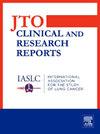BRAF Fusion as Resistance Mechanism to Osimertinib in EGFR-Mutated NSCLC: A Case Report and Review of Literature
IF 3.5
Q2 ONCOLOGY
引用次数: 0
Abstract
Despite the efficacy of osimertinib in the first-line treatment of advanced EGFR-mutated NSCLC, the development of resistance is nearly inevitable. BRAF mutations and fusions are reported in 1% to 3% of patients with EGFR-mutated NSCLC receiving osimertinib and represent potential targetable alterations.
In this case report, we discuss the rationale for EGFR-MEK co-inhibition in a patient with EGFR-mutated NSCLC treated with osimertinib that developed a CTNNA1-BRAF fusion at progression. In addition, we provide a brief overview of the current evidence of BRAF fusions as an acquired resistance mechanism to osimertinib and potential treatment strategies.
BRAF融合作为egfr突变的非小细胞肺癌对奥西替尼的耐药机制:一例报告和文献综述
尽管奥西替尼在一线治疗晚期egfr突变的NSCLC有疗效,但耐药的发展几乎是不可避免的。在接受奥西替尼治疗的egfr突变NSCLC患者中,有1%至3%的患者报告了BRAF突变和融合,这代表了潜在的靶向改变。在本病例报告中,我们讨论了在接受奥西替尼治疗的egfr突变NSCLC患者中发生CTNNA1-BRAF融合的EGFR-MEK共抑制的基本原理。此外,我们简要概述了BRAF融合作为对奥西替尼的获得性耐药机制和潜在治疗策略的现有证据。
本文章由计算机程序翻译,如有差异,请以英文原文为准。
求助全文
约1分钟内获得全文
求助全文
来源期刊

JTO Clinical and Research Reports
Medicine-Oncology
CiteScore
4.20
自引率
0.00%
发文量
145
审稿时长
19 weeks
 求助内容:
求助内容: 应助结果提醒方式:
应助结果提醒方式:


